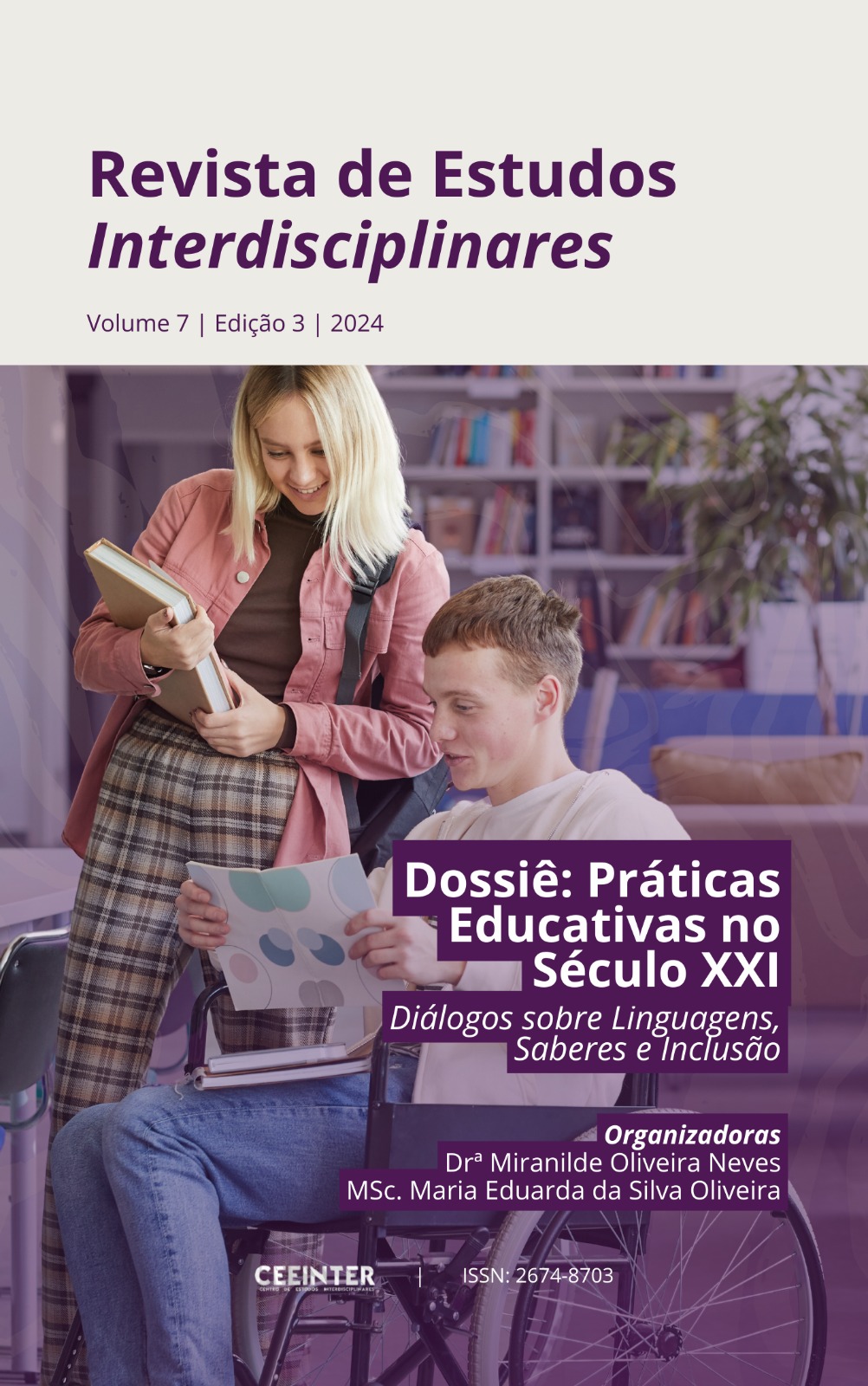ORAL NARRATIVES AND SYMBOLIC EDUCATION
PEDAGOGICAL LESSONS FROM THE NON-HUMAN AMAZONIAN UNIVERSE
Visualizações: 98DOI:
https://doi.org/10.56579/rei.v6i3.1531Keywords:
Oral narrative, Boto, Amazonian imaginary, Symbolic EducationAbstract
The aim of this paper is to understand how oral narratives related to the Boto teach and what they teach, considering the symbolic cultural and linguistic aspects. This is a qualitative study aimed at deepening our understanding of symbolic education in socio-communicative practices manifested in oral narratives related to the non-human entities that populate the Amazonian cosmological universe. The research questions are: Is there symbolic education through oral narratives? If so, in what way is this education presented or personified through the Boto? The study points out that the relationship between Symbolic Education and its students depends not just on the passage of the symbol, but on a whole cultural set that is built up daily, spontaneously, collectively, and sensitively in the various socio-communicative interactions. It is thus a collective education, built by everyone in the community who shares the same cultural and symbolic context.
Downloads
References
BAKHTIN, M. Estética da criação verbal. 6 ed. São Paulo: WMF Martins Fontes, [1979] 2011.
BORGES, A. da S. A. Educação Simbólica: o imaginário na Cantoria de Santinho em Povo Novo/ RS . Vol. 1. Porto Alegre: Mundo Acadêmico, 2022.
BORGES, A. da S; FIGUEIRA-CARDOSO, S. (2022). A Common Archetype: Imaginary and Linguistic-Discursive Analysis of the Heroic Feminine in Brazilian and Polish Folk Narratives. In: Ameryka Łacińska 2022; v. 30, n. 3 p. 101-122. DOI: 10.7311/20811152.2022.117.06
BRASIL. Ministério de Educação e Cultura. LDB - Lei nº 9394/96, de 20 de dezembro de 1996.
CARVALHO, L. G. Tradições devotas, lúdicas inovações: o Sairé em múltiplas versões. Sociologia & Antropologia, v. 6, n. 1, p. 237–259, jan. 2016.
DÉGH, L. Legend and belief: dialectics of a folklore genre. Bloomington: Indiana University Press, 2001.
DURAND, G . A imaginação simbólica. São Paulo: Cultrix, 1988.
DURAND, G. As estruturas antropológicas do imaginário. São Paulo: WMF Martins Fontes, 2012.
DURANTI, A. (2006), ‘Transcripts, like shadows on a wall’. Mind, Culture, and Activity 13(4), 301–310.
FARES, J. O boto, um Dândi das águas amazônicas. Revista Moara, Belém, v. 1, n. 5, p.47-63, abr.-set.. 1996.
FIGUEIRA-CARDOSO, S. Digital Text and Brazilian Folklore: Discussion on Referential Activity and Beyond. Academic Journal Of Modern Philology, v. 19, p. 49-64. 2023.
FIGUEIRA-CARDOSO, S. A construção de objetos de discurso em produções textuais descritivas na aula de PLA: O caso a Cuca e o pescador. PORTUGUESE LANGUAGE JOURNAL, v. 16, p. 1-11, 2022.
IBGE. Enciclopédia dos Municípios Brasileiros. Rio de Janeiro : IBGE, 1957. v. 14, p. 328-329. Disponível em: http://biblioteca.ibge.gov.br/visualizacao/livros/liv27295_14.pdf. Acesso em: jan. 2014.
KIBRIK, A. A. Reference in discourse. Oxford University Press, 2011.
KOCH, I. G. V. Introdução à linguística textual: trajetória e grandes temas. 2. ed. São Paulo: Editora Contexto, 2021.
MARCUSCHI, L. A. Produção textual, análise de gêneros e compreensão. São Paulo: Parábola Editorial, 2008.
MARCUSCHI, L. A. Da fala para a escrita: atividades de retextualização. 10. ed. São Paulo, Cortez Editora, 2010.
PAIVA, V. L. M. O. Manual de pesquisa em estudos linguísticos. São Paulo: Parábola Editorial, 2019.
POPPER, K. R. Conjectures and refutations: the growth of scientific knowledge. New York: Basic Books, 1963.
SANTOS, L. S. et al.. A medicina tradicional ribeirinha em vozes femininas. Boletim do Museu Paraense Emílio Goeldi. Ciências Humanas, v. 18, n. 1, p. e20210068. 2023.
TEIXEIRA, M. C. S. A contribuição da obra de Gilbert Durand para a Educação. In: CHAVES, I. M. A. B.; ALMEIDA, R. de (Org.). 100 anos Gilbert Durand. São Paulo: FEUSP, 2022.
TEIXEIRA, M. C. S. Contribuição da obra de Gilbert Durand para a educação: conceitos e derivações para uma pedagogia do imaginário. Educere et Educare, [S. l.], v. 11, n. 21, 2000. DOI: 10.17648/educare.v11i21.13897. Disponível em: https://e-revista.unioeste.br/index.php/educereeteducare/article/view/13897. Acesso em: 23 fev. 2024.
VAZ FILHO, F. A; CARVALHO, L. G. Isso tudo é encantado: histórias, memórias e conhecimentos dos povos amazônicos. Petrópolis-RJ: Vozes, 2023.
WANZELER, Z. C. S. Boto em gente, gente em boto: saberes, memória e educação na Amazônia. 153 f. Dissertação de Mestrado em Educação – Universidade do Estado do Pará, Belém, 2014.
WANZELER, Z. C. S. . Boto em gente, gente em boto: narrativa oral, educação e meio ambiente. Anais do Congresso Nacional de Educação , v. 1, p. 29822-29834, 2013.
WAWZYNIAK, J. V. Humanos e não-humanos no universo transformacional dos ribeirinhos do rio Tapajós – Pará. Mediações - Revista de Ciências Sociais, Londrina, v. 17, n. 1, p. 17–32, 2012. DOI: 10.5433/2176-6665.2012v17n1p17.

Downloads
Published
How to Cite
Issue
Section
License
Copyright (c) 2024 Interdisciplinary Studies Journal

This work is licensed under a Creative Commons Attribution 4.0 International License.
The Journal of Interdisciplinary Studies adopts the Creative Commons Attribution 4.0 International License (CC BY 4.0), which allows for sharing and adapting the work, including for commercial purposes, provided proper attribution is given and the original publication in this journal is acknowledged.

